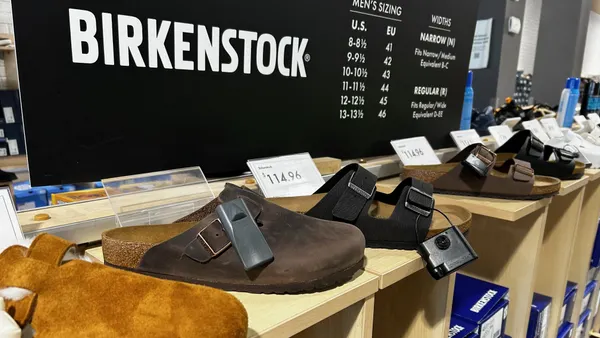Dive Brief:
-
Sears Holdings Corp. vendors say they’re scaling back deliveries and hiking payment terms in light of increased doubts about the embattled retailer's financial stability, Reuters reports.
-
Sears Holdings shares have plummeted since the Tuesday filing of the company’s annual report, in which it expressed diminished hopes in its ability to continue operating as a going concern.
-
Sears Holdings CFO Jason Hollar on Wednesday published a company blog post in an effort to downplay the company’s risky financial position, outlining key financial moves and saying that media reaction to the filing “do not include the full disclosure which highlights the actions we are taking to mitigate those risks."
Dive Insight:
Hollar's blog details a range of actions including a liquidity increase of up to $1 billion through its Secured Loan Facility and a standby letter of credit facility; an amendment to its existing asset-based credit facility in February that provides an additional $250 million of financial flexibility; a restructuring program to deliver at least $1 billion in annualized cost savings; its $900 million sale of its Craftsman tool unit; the monetization in late January of five Sears full-line stores and two Sears Auto Centers for $72.5 million; and an additional $105 million in gross proceeds from the sale of three Sears full-line stores.
“It is very important to reiterate that Sears Holdings remains focused on executing our transformation plan and will continue to take actions to help ensure our competitiveness and ability to continue to meet our financial obligations,” Hollar writes.
Sears also reiterated in Tuesday's report its moves to improve its customer experience, including a new Sears MasterCard with enhanced Shop Your Way loyalty rewards, an expanded partnership with Uber to boost rider rewards, mobile capabilities to enhance its Home Services operations and new services in its Auto Center business.
But it's all the equivalent of “taking an Advil to cure a heart attack,” GlobalData Retail managing director Neil Saunders told Retail Dive in an email earlier this month, adding that the results in Sears' recent fourth quarter earnings report can only be described as dire. “Not only are sales down, but the pace of decline has accelerated sharply,” Saunders noted.
Vendor hesitation to make deliveries will only exacerbate the already existing problem of poorly stocked stores, which has hurt Sears and Kmart as the company dedicates its finances to prop up the company rather than attend to retail fundamentals. "Whatever vendors continue to support them are now going to put them on even more of a short string. That means they’ll ship them smaller quantities and demand payment either in advance or immediately upon delivery,” Mark Cohen, the former chief executive of Sears Canada and director of retail studies at Columbia Business School, told Reuters. "Sears stores are pathetically badly inventoried today and they will become worse."
Both Sears (once a fixture of the American retail landscape and, in its golden era, a disrupter akin to Amazon) and sibling Kmart (once an iconic retailer in its own right) simply aren’t selling what consumers are buying. “On the contrary: [Sears'] product mix, its store environments, its customer service, and its general approach to retailing are actively deterring consumers from visiting,” Saunders said. “Kmart is in much the same position. In ordinary times this would be more than sufficient to cause major problems; in today’s pressured and competitive retail environment we believe that these things will ultimately prove fatal.”
Sears Holdings did manage to shrink its losses amid belt-tightening and inventory management during the fourth quarter of 2016. Still, full-year 2016 revenues were $22.1 billion compared to $25.1 billion in the prior year, due mostly to a decline of $1.3 billion from having fewer Kmart and Sears stores; full-year same-store sales declined 7.4%, with Sears down 9.3% and Kmart falling 5.3%.
Moody’s Investors Service downgraded Sears in January and said in a note Wednesday that while the annual report disclosures didn’t imperil its credit further, the company faces ongoing challenges over the next 12 months and remains a credit negative.
“Sears’ rating reflects the company’s sizable operating losses of approximately $1.8 billion in fiscal 2016,” Moody’s Senior Analyst Christina Boni said in an email to Retail Dive. “Although the company continues to take significant steps to improve its liquidity, it is uncertain if the company’s operational strategies will be sufficient to reduce its cash burn to break-even levels. Sears will continue to have sizable assets upon completion of its plans, but its debts are significant, with approximately $4.2 billion of funded debt at the end of the fourth quarter and unfunded pension and retirement obligations of approximately $1.8 billion.”
Sears Holdings also faces problems at Kmart in particular because of that unit’s meaningful market share erosion, Boni added. Ratings could be upgraded if the company were to make meaningful progress improving operating results while maintaining an adequate liquidity profile, she said. Ratings could be lowered if Sears' unencumbered asset base continued to erode while adjusted EBITDA losses remained significant and asset sale proceeds primarily used to fund operating losses, and if the company's liquidity were to become more constrained, operating losses widened beyond current levels, or if probability of default were to otherwise increase.














